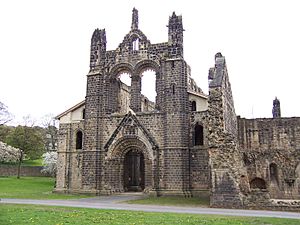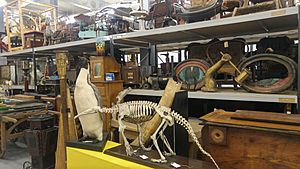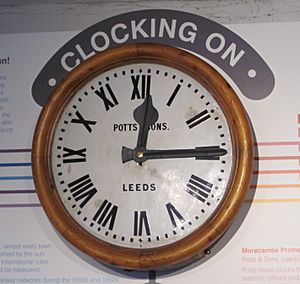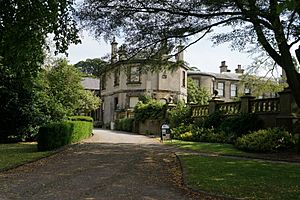- This page was last modified on 17 October 2025, at 10:18. Suggest an edit.
Leeds Museums & Galleries facts for kids
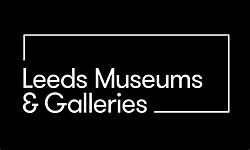 |
|
| Type | Local Authority Museum Service |
|---|---|
| Headquarters | Leeds |
| Location |
|
| Origins | Created by Leeds City Council to manage the city's museums and galleries |
|
Area served
|
Yorkshire |
| Services | Operating Leeds' city-owned museums and galleries |
|
Director
|
David Hopes |
|
Employees
|
146 |
|
Volunteers
|
<200 |
Leeds Museums and Galleries is a group of museums and art galleries managed by the Leeds City Council in West Yorkshire, England. It looks after eight different places, making it the biggest museum service run by a local council in England and Wales. These museums and galleries help people learn about history, art, and science. They also help protect important objects and stories for the future.
Contents
Places to Visit
Leeds Museums and Galleries manages many exciting places you can explore:
- Abbey House Museum
- Kirkstall Abbey
- Leeds Art Gallery
- Leeds City Museum
- Leeds Discovery Centre
- Leeds Industrial Museum
- Lotherton Hall
- Temple Newsam
Who Visits and Why
Lots of people visit these museums and galleries! In 2018–2019, over 1.7 million visitors came to the different sites. These visitors helped the local economy by spending money in the area.
The museums also focus on learning. They created the 'Leeds Curriculum', which is a set of teaching materials for schools. This program won an award for being an "Educational Initiative of the Year." It helps students learn about Leeds's history and culture.
History of the Museums
The story of Leeds Museums & Galleries began a long time ago.
Early Beginnings
The first museum started in 1821. It was part of the Leeds Philosophical and Literary Society. In 1921, Leeds City Council bought this collection. It then became the municipal museum, known today as Leeds City Museum.
In 1928, Abbey House Museum was bought to show social history. Kirkstall Abbey also became part of the museum service around this time. Sadly, in 1941, the museum was bombed during a war, and some collections were lost.
New Museums Open
Later, more museums opened. The Leeds Industrial Museum welcomed visitors in 1982. Famous TV presenters from Blue Peter were there for the opening!
In 1990, Thwaite Mills opened as a museum. However, it closed to the public on April 1, 2024, as its lease ended. In 2007, the Leeds Discovery Centre opened. Here, people can see collections "behind the scenes" in a special storage area.
Art Galleries Join In
Meanwhile, Leeds Art Gallery had been open since 1888. It was started with money from the public. In 1921, Leeds City Council bought Temple Newsam House. This historic house became another place to show art.
In 1969, Lotherton Hall was given to the people of Leeds. This added another beautiful art venue to the city.
Combining Services
Finally, in 1996, all these different museums and art galleries joined together. They formed what we now know as Leeds Museums & Galleries.
Amazing Collections
Leeds Museums & Galleries has about 1.3 million objects! These items are grouped into different collections:
- Natural Science: Over 800,000 specimens from all over the world. This includes stuffed animals (taxidermy), dried plants (herbaria), shells, rocks, insects, and things kept in liquid.
- Archaeology & Numismatics: Objects from ancient times and different cultures. This includes a large collection of coins and medals.
- Dress and Textiles: Clothes and fabrics, mostly from Britain. There are many items related to the clothing industry in Leeds.
- Fine Art: Paintings, drawings, and sculptures. It has strong collections of 18th and early 19th-century English watercolors. It also has a large collection of modern British sculptures.
- Industrial History: Items from Leeds's industrial past. This includes tools, machines, factory products, old papers, and photos.
- Social History: This collection shows how people lived in the past. It includes toys, items from shops, household objects, musical instruments, and old printed materials.
- World Cultures: Over 12,000 items from different cultures around the world. These show Leeds's connections to other countries and its diverse community.
- Decorative Art: Beautiful objects made by local craftspeople. This includes furniture, pottery, wallpapers, modern crafts, metalwork, and costumes.
Some of these collections are so important that Arts Council England has given them "Designated" status. This means they are nationally or internationally important. Researchers often study these collections. For example, they have looked at ancient Roman forks or the height of Egyptian mummies. The museums continue to add new items, like objects found during archaeological digs. A famous Egyptian priest named Nesyamun is on display at Leeds City Museum and is studied by many experts.
From 2014 to 2018, the museums ran a program about the First World War. It explored how the war affected Leeds and involved people across the city.
Online Collections
You can even see some of Leeds Museums and Galleries' collections online! They have partnered with Google Arts & Culture to share their treasures with the world.
How the Museums are Funded
Leeds City Council mainly runs and funds Leeds Museums & Galleries. The service is well-known in the region, nationally, and even internationally.
In 2012, the organization received "Major Partner Museum" status from Arts Council England. This brought extra money to help them grow and improve their work. This status continued in 2015. In 2018, they were given "National Portfolio Organisation" status until 2022, showing their continued importance.
See also
- Henry Denny
- Violet Crowther
- Emily Wardman
- Evelyn Silber
- Leeds Tiger
- John Grimshaw Wilkinson

